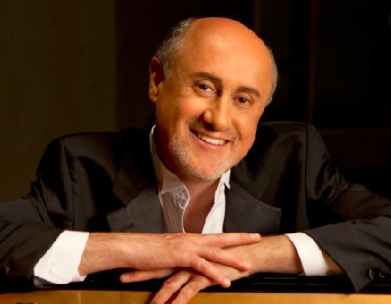|
Symphony
SRS SEASON ENDS WITH RESOUNDING TA-TA-TA-BANG
by Terry McNeill
Sunday, June 1, 2025
Symphony
YOUTHFUL VIRTUOSITY ON DISPLAY AT USO'S MAY CONCERTS
by Peter Lert
Saturday, May 17, 2025
Symphony
MYSTICAL PLANETS AND LIVELY GERSHWIN ORTIZ AT FINAL SRS CONCERT
by Peter Lert
Sunday, May 4, 2025
Symphony
VSO'S CONCERT MUSIC OF TIME, MUSIC OF PLACE
by Peter Lert
Sunday, April 27, 2025
Choral and Vocal
VOCAL ELEGANCE AND FIRE AT THE 222'S RECITAL APRIL 26
by Pamela Hicks Gailey
Saturday, April 26, 2025
CANTIAMO SONOMA SINGS AN INSPIRED GOOD FRIDAY MOZART REQUIEM CONCERT
by Pamela Hicks Gailey
Friday, April 18, 2025
DRAMATIC SHOSTAKOVICH SYMPHONY CLOSES PHILHARMONIC'S 25TH SEASON
by Terry McNeill
Sunday, April 13, 2025
LARGE COLLEGE OF MARIN AUDIENCE GREETS STOPHER ARTISTRY
by Terry McNeill
Saturday, April 5, 2025
Chamber
FRISSON DELIVERS SHIVERS OF DELIGHT
by Abby Wasserman
Sunday, March 30, 2025
OLD AND MOSTLY NEW IN SRS MARCH CONCERT IN WEILL
by Peter Lert
Saturday, March 22, 2025
|
 |
 Pianist Dmitry Rachmanov |
ECLECTIC PIANISM IN SPRING LAKE VILLAGE VIRTUAL RECITAL
by Terry McNeill
Wednesday, May 5, 2021
During the pandemic The Santa Rosa Symphonyís virtual concerts received their due in performance praise, but another series, Spring Lake Village, more quietly presented monthly virtual concerts to a select local audience.
May 5 saw the latest event, produced by impresario Robert Hayden, and featured Russian-American virtuoso pianist Dmitry Rachmanov in an eclectic hour-long recital of familiar but beautifully played compositions. The artist, faculty pianist at Cal State Northridge, is no stranger to Sonoma County audiences, as he has appeared on Concerts Grand, in a previous SLV engagement, and in an all Scriabin Weill Hall recital for SSU Prof. Marilyn Thompsonís piano course.
Mr. Rachmanov began with a work new to his catholic repertoire, Beethovenís E Flat Sonata, Op. 81a (Les Adieux). He didnít linger in the slow opening, and turned his warm tonal palette in the Adagio-Allegro to advantage, keeping the fast staccato chords clear. He brought out the melancholic nature of the following Adagio, and his subtle and balanced pianism perfectly depicted the triumphal finale. It was a joyous interpretation with carefully graded sonics.
Brahmsí Op. 118 ďSix PiecesĒ were written fours years before his death, and their autumnal character always seems to me to need playing only late in the evening with no one about. Happily in the video this was possible in the artistís playing of the first three in the set Ė A Minor and A Major Intermezzos and G Minor Ballade. The first had an explosive interpretation with grand sweep, and the A Major unfolded with tenderness and melodic charm. The pianistís sensitive legato phrasing in the Balladeís middle section contrasted the fiery nature of the two outer sections.
All through the video, filmed in Mr. Rachmanovís home, the recorded sound was plangent and several camera angles were used. Visual fades were flawless. The concert instrument had a clarion sound, but was never overly bright in the homeís small space.
Two Chopin works of mostly opposite character came next, the B Major Nocturne of Op. 9, and the propulsive C-Sharp Minor Study, Op. 10, No. 4. Both received masterful playing with the Nocturneís focus alternatively stormy and then full of vocal filigree. Rubatos were authoritative and sparse. The toccata-like Etude was surprising underplayed, the usual speed slowed for desired shape and clarity.
Russian composers completed the recital beginning with three Scriabin works Ė the two Impromptus from Op. 14, and the Prelude in F-Sharp Minor, Op.15, No. 2. Mr. Rachmanov has been a Scriabin champion since his student days and is a scholar of the composerís unique chromatic harmonic music, and is now recording in New York the almost the entire corpus. The Op. 14 works (B Major and F-Sharp Minor) owe much to Chopin, and are seldom played. The pianist caught the wistful nostalgia of the B Major, and gracefully brought out rhythmic left-hand rocking figurations in the somber F-Sharp Minor. Lyrical harmonic progressions and brisk swirls of notes characterized the playing of the short Prelude, another uncommonly performed piece.
Mr. Rachmanovís elegant and balanced playing was again heard in Rachmaninoffís sweetly serene E-Flat Major Prelude from Op. 23. Itís softly ascending and descending motifs in the artistís interpretation gave a serene charm to the Prelude composed in 1904, and the concertís concluding Etude Tableaux (Op. 33, No. 7), in the same key as the preceding Prelude, was broadly conceived from the trumpet-like call to arms at the beginning to forte repeated chords leading to the end.
Perhaps lacking the last ounce of momentum, Mr. Rachmanovís performance was still compelling and thoroughly captured the composerís muscular conception.
|

